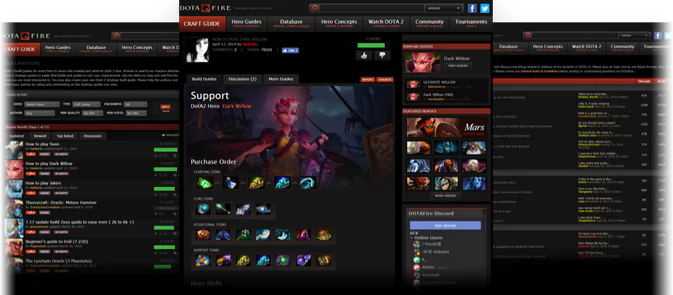
공유하다:
As a beginner in the world of data analysis, I sought a real-world project to apply the skills I was learning in my studies. While many would use their new knowledge to tackle significant issues, I decided to start small and solve a problem that was both accessible and interesting to me: improving my performance in Dota 2. Despite my relatively low skill level in the game, I wanted to find out if I could use data analysis to become better without investing countless hours into practice or watching tutorials.
This is my story of how I used data analysis to improve my results in Dota 2, one of the most popular multiplayer online battle arena (MOBA) games.
The Problem: Improving Performance with Limited Time
The main challenge I faced was the desire to improve at Dota 2 while not having the time or inclination to spend hours upon hours playing or watching guides. Like many casual gamers, I didn’t want to dedicate a significant portion of my life to mastering the game, but I still wanted to improve. This led me to the question: Could I increase my win rate simply by analyzing my previous games without the need for intense practice?
I set a modest goal: if I could increase my win rate by at least 2%, I would consider it a success.
Data Collection: Analyzing My Matches
To begin, I played 50 matches of Dota 2. Why 50? Given my limited time and commitment, 50 matches seemed like a manageable amount. The goal was to gather enough data to identify trends and areas for improvement. I chose to focus on these 50 games rather than analyzing older matches, as I wanted to ensure that my approach was conscious and intentional.
Collecting the data posed a challenge. While websites like Dotabuff track match
stats, I found it difficult to extract the data in a convenient format. After considering options, I decided that manually recording the data would be the best approach for my needs. Using Excel, I created a spreadsheet where I tracked key metrics like the date of each match, the role I played, the heroes I used, the heroes I faced, and the performance of my teammates.Tools and Methods: Excel for Data Analysis
Excel became my go-to tool for analysis. Given the relatively small size of my dataset, Excel provided all the functions and tools I needed to analyze the data efficiently. I used features like Pivot Tables, conditional formatting, and various statistical functions (COUNTIF, AVERAGE, MIN, MAX) to derive insights from my data.
The data I collected allowed me to see an overview of my performance, including my win rate, the heroes I played most often, and which heroes I struggled against. One of the first things I noticed was that my win rate was 58% across the 50 matches. While this was a decent start, I hoped to improve it further.
In-Depth Analysis: Understanding the Causes of My Losses
Next, I dove deeper into the data to identify patterns and reasons for my losses. I created a Pivot Table to analyze my performance with different heroes. One hero stood out: Monkey King, which I played in 33 of my 50 matches. Upon examining my results with this hero, I noticed I had significant trouble against certain opponents like Necrophos, Zeus, and Puck. This prompted me to focus on improving my play against these heroes.
Additionally, I found that my results were influenced by the heroes my friends played. Since I often team up with the same group of people, I analyzed which heroes they used most often and how those choices impacted my win rate. This revealed some patterns where certain heroes in my friends’ hands negatively affected my chances of winning.
Key Insights and Adjustments
From the analysis, I extracted two key takeaways:
- Hero Matchups: I needed to learn how to counter or avoid certain heroes that consistently defeated me, like Necrophos, Zeus, and Puck.
- Teammate Synergy: My results were better when my friends played specific heroes. By suggesting better hero picks to my friends, I could improve our overall chances of winning.
These insights helped me make conscious adjustments to my gameplay. For example, I started researching strategies for dealing with my problematic opponents and communicated with my friends about the heroes that seemed to perform better when paired with mine.
Implementing Changes and Observing Results
After implementing these changes, I played another 50 matches. This time, my win rate improved to 64%, a 6% increase from my original 58%. While this result may seem modest, it was a clear indicator that my analysis and adjustments had a positive effect.
These improvements came from small but meaningful changes—adjusting my hero choices, learning how to counter specific heroes, and improving coordination with my teammates. While there are many other factors in Dota 2 that influence the outcome of a game, focusing on the ones I could control led to better results.
Conclusion: A Step Toward Data-Driven Gaming
This project was both a valuable exercise in applying data analysis techniques and a useful way to improve my gaming experience. By leveraging Excel and analyzing my own gameplay data, I was able to identify key areas for improvement and make changes that resulted in a higher win rate.
Though the problem I tackled might not be of global importance, the process of applying data analysis to a personal goal was rewarding. It also provided me with further experience in using tools like Excel and statistical functions. Moving forward, I plan to continue refining my data analysis skills and explore more complex projects, hopefully tackling more impactful problems.
For anyone looking to improve in a game like Dota 2, or any other competitive activity, remember that small, data-driven changes can lead to significant improvements. Even without spending countless hours on practice, it’s possible to enhance your performance by making thoughtful, informed decisions based on the data at hand.
















